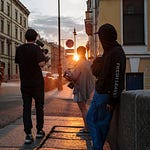Photo by Louis Maniquet on Unsplash
What’s the difference between creativity and imagination?
I remember the first time I read The Artist’s Way, one of the heavy hitters in the industry of creativity books. I was in a workaholic phase in my life, so I focused diligently on completing the exercises. I blew off her instructions to go on a weekly “artist’s date”—to go somewhere unfamiliar, to do something playful, just for fun. I told myself if I was thorough in answering her questions, it was ok that I didn’t have time to play. I completely missed the point.
I still read creativity books. They’re fun, full of tips, and they prop you up or cheer you on. Most authors start from the premise that the reader has creative potential and wants to make a thing, but is stuck in the process. There’s an underlying assumption that creativity seeks an output, that it wants to generate a material artifact, either as a goal in itself (think “art as creative expression”), or to make an impact on someone else, or to generate money for the creator.
Imagination seems less attached to an output. I think of imagination as an force, buoyant and inexhaustible, surging and sparking. It doesn’t need us, or want anything from us. We can choose to connect to it, but there’s no guarantee of safety—it might be a great experience; it might take us to our edge. Imagination is other-worldly, by which I mean it’s not necessarily bound by or linked to what is.
I’ve been thinking about creativity and imagination as ways to characterize the difference between reformist and revolutionary strategies for social change. Reformist strategies seek to improve and overhaul our current systems, organizations, and structures. They often start with an end goal in mind. Revolutionary strategies try to imagine an entirely new way of solving a problem, without necessarily being attached to things as they stand.
In design thinking, the question “How might we?” is a tactic to move people from creativity to imagination. It asks not “How should we improve this cup?”—which will inevitably produce more cups—but rather “How might we move liquid from one place to another?” which might be the end of cups as we know them.
Reform and revolution are often presented as oppositional strategies. There’s even a kind of dis involved, at times—the truly cool are the revolutionaries, while the reformists are over there, licking their pencils and ticking off boxes on their lists. In actuality, people often toggle back and forth between the two modes.
If we’re working in mental health, we might be using tools and strategies with clients that are focused on individual change or coping skills, even as we know that the trauma’s ultimate source is in interlocking networks of power and dominance that must be overthrown. We might be volunteering and in community with others who are pushing into the space of imagination, with one foot in the present system and the other in processes of radical transformation. Our dominant culture, too, is toggling back and forth between the now and the what will be, with some insisting that revolutionary change is urgent and required, and others arguing that the current system can handle the challenges of the present moment.
One thing I’ve been wondering about is this: what would “therapy” look like if its work was less that of creativity/reform and more that of imagination/revolution? What would it seek to heal? What strategies would we us, to do it? What would change if the field’s focus on trauma shifted from addressing the impact of interpersonal violence on individuals and communities to instead healing trauma’s ultimate source, the violence of inequality, systemic violence and oppression?
And because this is work that can only be accomplished when we put our imaginations together, when we share our lived experiences with one another, when we are transformed by engaging in collective action, I wonder: how might we create a “therapy” for social movements, which are special entities in and of themselves, beings made up of collectivities, far more complex than individuals?
Imagination is like faith. It reaches toward that which cannot be proven, seen, or languaged, and yet which is available as a felt sense in the body of the present. I know there are thousands of practitioners, advocates, change makers of all kinds out there, already doing this work, already transforming mental health, already treating trauma at the level of the system rather than the self. If you’re one of them, reading this, tell us: what is your imagination practice? What has it brought you? What is your vision for a therapy for movement building, that heals the social and along with it, our selves?













Share this post